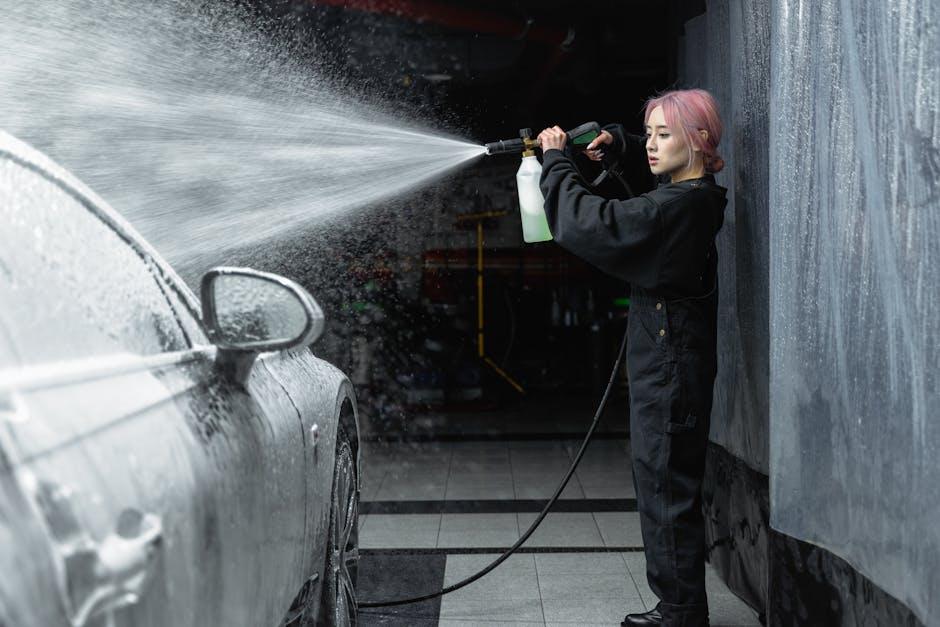In the intricate dance of moving parts beneath a vehicle’s hood, transmission fluid plays a silent yet vital role. Often overlooked and tucked away from everyday view, this unassuming liquid is the lifeblood of a car’s transmission system, ensuring smooth shifts and preventing costly wear and tear. But like any essential resource, it doesn’t last forever. Understanding the importance of regular transmission fluid changes is key to maintaining a vehicle’s health, performance, and longevity. This article explores why keeping your transmission fluid fresh is not just good practice—it’s essential for the road ahead.
Table of Contents
- The Crucial Role of Transmission Fluid in Vehicle Performance
- Signs Your Transmission Fluid Needs Changing Soon
- How Dirty Transmission Fluid Can Damage Your Car
- Choosing the Right Transmission Fluid for Your Vehicle
- Step-by-Step Guide to Changing Transmission Fluid Safely
- Expert Tips for Maintaining Transmission Health Between Changes
- Q&A
- Insights and Conclusions

The Crucial Role of Transmission Fluid in Vehicle Performance
Transmission fluid is the lifeblood of your vehicle’s transmission system, ensuring smooth gear shifts and optimal functionality. It not only lubricates the moving parts but also serves as a coolant, protecting the system from overheating and wear. Neglecting this vital fluid can lead to increased friction and heat, causing premature transmission failure. Regular maintenance and timely fluid changes help preserve the integrity of internal components, extending the lifespan of your vehicle’s transmission while maintaining efficient performance.
Key benefits of maintaining fresh transmission fluid include:
- Enhanced shifting precision and responsiveness
- Improved fuel efficiency through reduced strain
- Prevention of costly repairs by avoiding overheating and corrosion
- Consistent transmission temperature management
| Service Interval | Signs You Need a Change | Impact of Neglect |
|---|---|---|
| Every 30,000-60,000 miles | Delayed or rough shifting, fluid discoloration | Slipping gears, transmission overheating |
| More frequent for towing or heavy use | Unusual noises, burning smell | Complete transmission breakdown |

Signs Your Transmission Fluid Needs Changing Soon
Keeping a close eye on your vehicle’s transmission fluid can save you from costly repairs and unexpected breakdowns. One of the most obvious indicators is a noticeable color change—from a clear, bright red to a dark or murky brown. This shift signals contamination or degradation. You might also detect a burning smell when the fluid overheats, or observe that the fluid feels gritty or thick to the touch. These sensory warnings are your car’s way of saying it’s time for fresh fluid.
Other subtle signs include sluggish performance during gear shifts or an unusual noise coming from the transmission area. If your car hesitates or jerks when changing gears, it’s a red flag that the fluid is not lubricating as well as it should. Below is a quick checklist you can keep handy to monitor these changes:
- Dark, dirty transmission fluid
- Burnt odor from the fluid
- Delayed or rough gear shifts
- Transmission slipping
- Unusual noises when accelerating

How Dirty Transmission Fluid Can Damage Your Car
Dirty transmission fluid acts like contaminated oil in a high-performance engine—it chokes the system and creates friction where there should be smooth operation. Over time, grit and sludge build up, reducing the fluid’s ability to lubricate the transmission parts effectively. This increased friction causes excessive heat, which can prematurely wear down gears and other components, leading to costly repairs. A thick, dirty fluid also hampers the transmission’s ability to shift gears smoothly, resulting in jerky movements, delayed responses, or even complete transmission failure.
It’s not just wear and tear that dirty fluid promotes; it can also clog the narrow channels within your transmission, disrupting the flow of fluid and putting strain on the transmission pump. Here’s a quick look at what happens when fluid is neglected:
- Reduced lubrication leads to metal-on-metal contact
- Overheating due to poor heat dissipation
- Sluggish shifting and erratic gear changes
- Contaminant buildup blocking fluid channels
| Symptom | Cause | Potential Damage |
|---|---|---|
| Grinding Gears | Dirty fluid abrasion | Gear teeth wear |
| Delayed Shifting | Fluid clogging | Transmission overheating |
| Burnt Smell | Fluid losing effectiveness | Complete transmission failure |

Choosing the Right Transmission Fluid for Your Vehicle
Selecting the appropriate transmission fluid is essential for maintaining your vehicle’s performance and longevity. Different vehicles require specific types of fluids based on their design and transmission technology, such as automatic, manual, or CVT systems. Using the wrong fluid can lead to inefficient gear shifts, overheating, and even costly transmission damage. Always consult your vehicle’s owner’s manual or a trusted automotive professional to ensure compatibility and optimal protection.
To simplify your choice, consider the following factors:
- Manufacturer Specifications: Look for fluids that meet or exceed the standards set by your vehicle’s maker.
- Fluid Type: Automatic Transmission Fluid (ATF), Synthetic, or conventional—each designed for different uses and performance levels.
- Temperature Range: Choose fluids that perform well in your driving climate to prevent breakdown at extreme temperatures.
| Transmission Type | Recommended Fluid | Key Benefit |
|---|---|---|
| Automatic | Dexron VI / Mercon LV | Improved friction and temperature resistance |
| Manual | MTF (Manual Transmission Fluid) | Enhanced gear protection and smooth shifting |
| CVT | CVT Fluid | Optimized viscosity for variable pulley systems |

Step-by-Step Guide to Changing Transmission Fluid Safely
Before diving into the fluid swap, gather all necessary tools and materials: a jack and stands, a fluid catch pan, a drain plug wrench, replacement transmission fluid suitable for your vehicle, and a new filter if applicable. Start by ensuring your vehicle is parked on a level surface and the engine is cooled down. Securely lift the car and place it on stands, then position the catch pan beneath the transmission’s drain plug. Carefully remove the plug to let the old fluid drain out completely; this step is crucial to remove built-up contaminants and prevent damage to your transmission components.
Once drained, replace the drain plug and, if your car has a transmission filter, now is the time to swap it out. Using a funnel, refill the transmission with the recommended quantity of fresh fluid through the dipstick tube or designated fill port. Afterward, start the engine and cycle through the gears slowly to allow the new fluid to circulate evenly. Check the fluid level with the dipstick and top off as necessary. Your vehicle is now primed for smoother, more efficient shifting and extended transmission health.
- Safety first: Always wear gloves and eye protection.
- Use the right fluid: Consult your owner’s manual.
- Dispose of old fluid properly: Take it to a recycling center.
| Step | Estimated Time | Tip |
|---|---|---|
| Drain Old Fluid | 10 minutes | Warm engine helps fluid flow |
| Replace Filter | 15 minutes | Check for wear or damage |
| Fill New Fluid | 8 minutes | Use a funnel for mess-free pouring |
| Check Level | 5 minutes | Keep engine running for accuracy |

Expert Tips for Maintaining Transmission Health Between Changes
Keeping your transmission in prime condition between fluid changes requires a combination of consistent care and smart driving habits. One of the most effective ways to extend the life of your transmission fluid is by avoiding abrupt stops and rapid accelerations, which put extra strain on transmission components. Additionally, make a habit of checking the fluid level and quality every few thousand miles—clean, clear fluid is a good indicator of a healthy transmission system.
Incorporating these simple yet impactful practices can make all the difference:
- Use the correct transmission fluid type recommended by your vehicle’s manufacturer.
- Keep the cooling system in check because overheated transmissions degrade fluid rapidly.
- Avoid towing loads heavier than your vehicle’s rating to prevent excessive heat buildup.
| Care Tip | Benefit |
|---|---|
| Regular fluid inspections | Catch early signs of contamination or wear |
| Driving smoothly | Reduces stress on transmission gears |
| Cooling system maintenance | Prevents overheating and fluid breakdown |
Q&A
Q&A:
Q1: What exactly is transmission fluid, and why does it matter?
A1: Transmission fluid is the lifeblood of your car’s transmission system. It lubricates the moving parts, helps transmit power from the engine to the wheels, and cools the transmission to prevent overheating. Without fresh transmission fluid, the whole system can grind to a costly halt.
Q2: How often should transmission fluid be changed?
A2: The answer isn’t one-size-fits-all. Generally, manufacturers recommend changing transmission fluid every 30,000 to 60,000 miles. However, this can vary based on your vehicle’s make, model, and driving conditions. Checking your owner’s manual is your best bet.
Q3: What happens if I don’t change my transmission fluid regularly?
A3: Over time, transmission fluid breaks down and becomes contaminated with debris and metal shavings. This dirty fluid can cause your transmission to slip, shift roughly, or even fail outright—leading to expensive repairs and unsafe driving conditions.
Q4: Can I just add transmission fluid instead of changing it?
A4: Adding fluid can temporarily fix low fluid levels, but it doesn’t replace the worn-out, contaminated fluid already inside. A full fluid change flushes out the old, degraded liquid and replaces it with fresh fluid for optimal performance.
Q5: Is changing transmission fluid a DIY job?
A5: Some car enthusiasts with the right tools and knowledge can do it at home, but it can be tricky. Risk of spills, choosing the wrong fluid type, or improper refilling can cause damage. Many drivers prefer to trust professionals for this task.
Q6: How does changing transmission fluid extend my vehicle’s lifespan?
A6: Clean transmission fluid reduces wear and tear on your transmission’s delicate components. This means fewer breakdowns, smoother gear shifts, and less chance of overheating—ultimately prolonging the life of your vehicle’s drivetrain.
Q7: Are there different types of transmission fluid?
A7: Absolutely. Automatic, manual, and continuously variable transmissions (CVTs) all require specific kinds of fluid. Using the wrong type can cause serious damage, so always check your vehicle’s specifications before refilling or changing the fluid.
Q8: Can regular transmission fluid changes improve fuel efficiency?
A8: Indirectly, yes. A well-lubricated transmission shifts more efficiently, which can help your engine work less hard and improve overall fuel economy. It’s a small change that adds up over time.
Q9: How do I know it’s time for a transmission fluid change?
A9: Aside from mileage-based guidelines, watch for signs like delayed or jerky shifts, strange noises, or a burning smell. These can indicate your transmission fluid is struggling and needs attention.
Q10: Is transmission fluid change important for both new and old cars?
A10: Yes! Even though newer cars may have longer intervals between changes thanks to advanced fluids, all vehicles benefit from clean transmission fluid. For older cars, it’s especially crucial to prevent costly repairs down the road.
Keeping your transmission fluid fresh is like giving your car a regular health check-up—it keeps things running smoothly beneath the surface, so you can enjoy the ride without unexpected breakdowns.
Insights and Conclusions
In the intricate dance of gears and pistons that powers your vehicle, transmission fluid may be the quietest partner—but it’s undeniably essential. Regularly changing this vital lubricant not only preserves the harmony of your transmission but also extends the life of your car, saves you money, and keeps your journeys smooth and worry-free. By giving your transmission fluid the attention it deserves, you’re investing in reliability and performance that can carry you many miles down the road. After all, sometimes the smallest maintenance acts play the biggest roles in the story of a well-kept vehicle.

